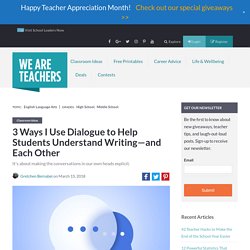

10-Minute Journaling Activities to Kick Off the Class. Journaling at the start of class is an excellent way for middle school and high school students to get into the right mindset to learn.

Some students may enter your English classroom ready to dive into a text or a writing assignment, but many students need to ease into the material, and getting thoughts flowing on paper is a great way to do this. While it may be sufficient to tell students to write for a few minutes about whatever is on their minds, it can be helpful for many students if you provide guidance or a general topic for their writing. Here are four 10-minute journaling activities to use at the start of the secondary English class. 1. Picture journaling in the secondary ELA classroom For this exercise, find an interesting photo online and project it onto the board so that all your students can see it.
If you have a larger class or if your students are not all comfortable sharing, split the class into pairs so people can share with one other person. 2. 3. 4. Ecrire : Construire une représentation du vocabulaire des sentiments. Benefits of Cursive Instruction in the Classroom. According to the USA Today, 41 states no longer require handwriting instruction.

That’s not surprising, since the Common Core has shifted the focus to skills which support technology, like keyboarding instruction. But the benefits of handwriting, and cursive in particular, have long been documented. In addition to the effects on brain development, handwriting helps students build fine motor skills and dexterity, and leads to greater engagement and retention. In addition, research shows that cursive writing is beneficial for students with learning disabilities. Here are a few ways cursive instruction benefits students. Brain development According to a study conducted by the University of Washington, learning to print, write in cursive, and type on a keyboard all contribute to brain development in students.
The key difference is that cursive writing stimulates brain synapses and the synchronicity between both sides of the brain, unlike printing or typing. Stirring Students’ Imaginations. For example, when I say, “Use your imagination,” people are likely to go inward to what could be called an internal visual world.

One’s eyes might even shift downward or inward, or one might close them entirely. This occurs naturally and tends to demonstrate that imagination is a type of experience that happens inside of people, as if it were glimpses of a projected film that you view. Researchers continue to speculate that this internal mind’s eye is capable of many things. It helps perception go beyond the constraints of time and space. As a result, an individual can visualize or predict the imminent or distant future by filling in information. Giving Peer Feedback Helps Writers Grow. I recently participated in a two-session writing class, and at the end of the first session, we were tasked with writing a short scene that we would share and discuss in small groups the following week.

Knowing I was to share my work motivated me to put time and effort into it. I was both anxious and excited—I was curious to see what others thought of my work and to hear both criticism and validation. Workshopping is a very active process, both intellectually and behaviorally, and requires students to read, formulate comments and suggestions, and discuss in a small group setting. We often think only of the benefits of receiving feedback on work, namely that others’ suggestions can help writers improve a piece of writing. The Best Writing Prompts for Middle School. In middle school, the use of writing prompts are a wondrous thing.

Those simple sentences propel students into unleashing their creativity, understanding their core values and rethinking some of their past actions. They’re still coming of age so their responses can be emotional and insightful—for you and the student. Writing prompts are one of the most effective ways to develop confident writers who enjoy the process. We rounded up 24 of the best writing prompts for middle school students who are still finding their writing voice! 1. Les ateliers de l'école des loisirs. Vous devez envoyer votre manuscrit (œuvre de fiction), destiné à un lectorat entre 8 et 18 ans, paginé et non relié, par la poste avant le 1er février 2018, à : l’école des loisirs Les ateliers de l’école des loisirs 11, rue de Sèvres 75006 Paris 24 manuscrits seront retenus par l’école des loisirs.

Leurs auteurs en seront informés avant le 15 mars 2018. Grégory Devin : Ecrire en classe avec Twitter. Université d'automne du Snuipp : Dominique Bucheton : Refonder l'enseignement de l'écriture. Professeure honoraire à l'université de Montpellier II, Dominique Bucheton a enseigné en élémentaire, en collège et à l'IUFM avant de diriger le Laboratoire Interdisciplinaire de Recherche en Didactique, Éducation, Formation (LIRDEF).

Ses recherches portent sur les gestes professionnels des enseignants, les valeurs pédagogiques, la progression des élèves. « Nous faisons travailler les élèves fondamentalement pour qu'ils deviennent des gens qui pensent le monde autour d'eux et qui se pensent dans ce monde. C'est le rôle de l'école et c'est le sens de notre métier. » Refonder l'enseignement de l'écriture, Pourquoi ? L'écriture est au cœur des pannes de la démocratisation scolaire. 10 Best Writing Prompts for High School English Students. By the time students walk in the door of our secondary ELA classrooms, they’re not exactly new to writing assignments.

They’ve done autobiographies. Short stories. Ecrire pour mieux comprendre. Le travail sur la compréhension est au cœur des préoccupations de bien des enseignants depuis plusieurs années, et assurément de la mienne en tout cas.

Le sujet est revenu sur le devant de la scène récemment avec les enquêtes publiées durant l’année scolaire. We Should Use Dialogue to Teach Literacy, Says Gretchen Bernabei. Do your students spring to life when they see a play script coming?

They immediately begin to beg for roles—small ones, funny ones, starring roles, cameos, don’t they? It sounds familiar to you, doesn’t it? Students willingly participate in dialogues, especially when there is some argument built in. So do adults. In fact, that’s what readers and writers do. What Is Writing Workshop and How Do I Use It in the Classroom? If you’re new to teaching writing, you may have heard discussion about writing workshop but not be entirely sure about what it is or how to use it in your classroom. WeAreTeachers is here with the answer.
Mon rituel Jogging d'écriture. Writing Center Ideas That We Love. Make writing time the best time of day with these 10 great writing center ideas we found across the blogosphere! 1. Use dice to create original stories. SOURCE: WhereTheWIldThingsLearn Determine the story’s setting, main character, and plot with a roll of the dice.
Promouvoir l’usage du brouillon. En production d’écrits, il est souvent demandé aux élèves de faire un brouillon, avant la rédaction au propre d’un texte. Par expérience, nous savons que l’amélioration du brouillon vers le texte final est un acte difficile pour l’élève. Retour sur une recherche menée en 2013 [1] dans un lycée algérien qui porte sur l’analyse des pratiques des enseignants où l’utilisation d’une grille d’autoévaluation se révèle moins fructueuse que les commentaires écrits de l’enseignant. Six Truths I Know For Sure About Writing. After teaching writing for over 20 years, I’ve seen the benefits of having students write regularly, genuinely, and with ownership.
Of course, they perform better academically, in every subject and on standardized tests, since consistent writing practice trains students to easily access their thoughts and skillfully express them. But by writing often and with purpose, students also grow as thinkers and as human beings. Essay Revisions: How I Help Students Become Better Writers. When students have opportunities to revise their work and learn from their mistakes, growth happens. Providing students with the chance to edit their final essays after you grade them is one of the most beneficial learning opportunities for students.
However, giving students this extra chance to improve their writing also comes at a cost. It takes more time -time in which we don’t necessarily have. And even though giving students an extra opportunity to revise their already-turned-in-and-graded essays takes more time on our part, it is one of the best ways for students to actively work on improving their writing. In my classroom, I alternate how much essay revisions are weighted and worth. When I grade essays, I use a standard rubric consistently throughout the year. For the revisions, I ask students to review the rubric and improve on the categories in which they scored poorly.
6 Reasons Why Students Should Write Daily. Writing is a skill your students will use for the rest of their lives. When students write daily in the classroom, it will help them master this craft and prepare them for life beyond the classroom. Here are six more reasons why students should write every day: 1. 6 Reasons to Assign Essay Revisions. Writing is a cyclical process. And even though we have our students turn in final draft versions of their papers, any middle school or high school English teacher can tell you that these final drafts are quite far from final.